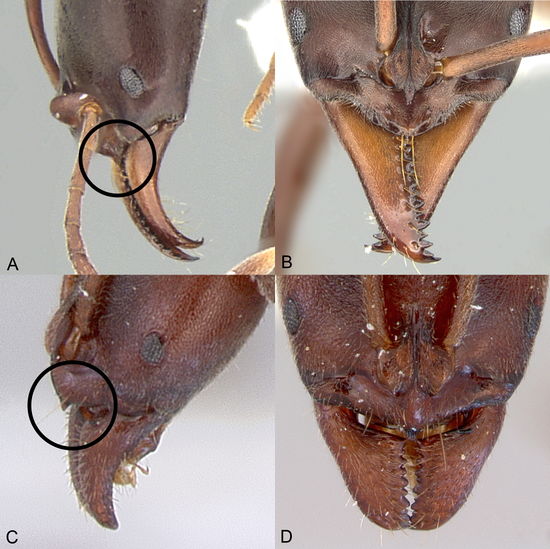Key to Australian Genera of Ponerinae
The following key to Australian genera of the subfamily Ponerinae has been modified from Schmidt & Shattuck (2014).[1]
1
- Clypeus broadly inserted between frontal lobes, which appear flattened in frontal view, the antennal sockets widely separated (Fig. A). Metatibia with two pectinate spurs. Tarsal claws usually armed with a single preapical tooth (rarely unarmed) => Platythyrea
- Clypeus narrowly inserted between frontal lobes, the antennal sockets closely approximated (Fig. B). Metatibia with either one or two spurs. Tarsal claws usually unarmed, sometimes pectinate or armed with a single tooth => 2
2
- Mandibles long and linear, inserted medially on the front of the head. Head with prominent ocular prominences (Fig. A) => 3
- Mandibles inserted toward the sides of the front of the head. Head without prominent ocular prominences (Fig. B) => 4
3
- Nuchal carina continuously curved, the posterior surface of the head lacking a pair of dark apophyseal lines (Fig. A) => Anochetus
- Nuchal carina medially V-shaped, the posterior surface of the head with a pair of dark converging apophyseal lines (Fig. B) => Odontomachus
4
- Mesotibiae dorsally with abundant stout traction setae (Fig. A) => Cryptopone
- Mesotibiae dorsally without abundant stout traction setae (a few stout setae sometimes present near tarsus but never extending along length of tibia) (Fig. B) => 5
5
- Ventral apex of the metatibia with a single spur, which is pectinate (Fig. A) => 6
- Ventral apex of the metatibia with both a large pectinate spur and a smaller simple spur (Fig. B) => 8
6
- Eyes absent. Mandibles elongate and narrow, the teeth small and widely spaced (Fig. A) => Iroponera
- Eyes present (although sometimes very small). Mandibles generally triangular but occasionally elongate, the teeth generally moderately sized (occasionally elongate) and evenly spaced (Fig. B) => 7
7
- Subpetiolar process with an anterior fenestra and paired posteroventral teeth (Fig. A) => Ponera
- Subpetiolar process without both an anterior fenestra and paired posteroventral teeth (Fig. B) => Hypoponera
8
- Tarsal claws pectinate (Fig. A) or armed with one or two preapical teeth => Leptogenys
- Tarsal claws unarmed (Fig. B) => 9
9
10
- Mesosoma with a deep pit anterior to each metanotal spiracle (Fig. A). Petiole with a pair of spines on the posterodorsal margin (Fig. A). Arolia prominent and white => Diacamma
- Mesosoma without deep pits laterally (Fig. B). Petiole rounded dorsally, without a pair of spines (Fig. B). Arolia not prominent and white => 11
11
- Compound eyes small (with 2-4 facets) or absent. Subpetiolar process with an anterior fenestra and/or a pair of teeth (Fig. A) => Parvaponera
- Compound eyes present and larger, with numerous facets. Subpetiolar process simple, without an anterior fenestra (Fig. B) => 12
12
- In frontal view, eyes located dorsally on head and separated from the lateral margin by a small gap (Fig. A). Additionally, with the following combination of characters: Head and body usually with both dense pilosity and dense pubescence; propodeum broad dorsally; petiole semicircular in dorsal profile and usually with a row of small teeth or denticles on the posterodorsal margin (angled or ridged in some Australian species); A3 tergite usually longitudinally striate => Pseudoneoponera
- In frontal view, eyes located laterally on head and touching or extending beyond the lateral margin (Fig. B). Additional characters not as above. => 13
13
- Head and body strongly sculptured (usually striate). Mesopleuron divided by a transverse groove. Petiolar node in dorsal view generally convex anteriorly and flat posteriorly (a few exceptions). Posterolateral margins of head angular (Fig. A) => Ectomomyrmex
- Head and body not strongly sculptured. Mesopleuron not divided. Petiolar node scale-like or block-like. Posterolateral margins of head rounded (Fig. B) => Pseudoponera
14
- Mandibles linear or subtriangular. Clypeus with a blunt anteromedial rectangular projection (Fig. A) => Myopias
- Mandibles triangular. Clypeus without a blunt anteromedial rectangular projection (Fig. B) => 15
15
- Mandible with a basal pit or groove. Prora absent from anterior margin of first gastral sternite (Fig. A) => Brachyponera
- Mandible without a basal pit or groove. Prora present on anterior margin of first gastral sternite (Fig. B) => 16
16
- In side view anterior clypeal margin angular and located against the mandibles (Fig. A). Mandibles elongate, their outer margins generally broadly and shallowely concave (Fig. B) => Mesoponera
- In side view anterior clypeal margin rounded, the anterior-most point located above the mandibles and clypeus meeting mandibles posteriorly to this point (Fig. C). Mandibles shorter, their outer margins generally flat or with separate convex sections separated by a slight medial angle (Fig. D) => Austroponera
References
- ↑ Schmidt, C.A. & Shattuck, S.O. 2014. The higher classification of the ant subfamily Ponerinae (Hymenoptera: Formicidae), with a review of ponerine ecology and behavior. Zootaxa. 3817, 1–242 (doi:10.11646/zootaxa.3817.1.1)















